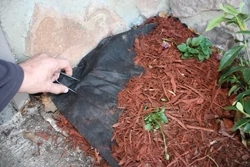Using Rock from a Creek Bed to Enhance a Flagstone Home
In an effort to shape up the curb appeal of one of our project houses, we decided to line a small rock garden with natural stone edging to match the flagstone walls of the home. The old garden border was a combination of black plastic landscaping border and the most unconvincing faux “brick” I’d ever seen.
Most of the plastic brick had long ago disappeared, leaving only a sad little fragment sticking from the ground like a sore thumb. So my first move was to use a pair of Channellock’s to pull up the old edging.
I collected a selection of flat(-ish) flagstones from a creek bed. They ranged in size roughly from 7 to 12 inches long. I was looking for a variety of browns, reds and grays to match the color scheme of the home’s existing flagstone. Choose stones of an approximate shape and size that will best fit the landscape plot, bearing in mind that at least half the stone will need to be buried below grade in order to keep the border sturdy. If you don’t have access to a creek bed, many home-improvement outlets and landscaping supply centers sell natural stone.
It’s best to have the dirt work of the garden plot completed before installing the edging, otherwise the gardening activity may loosen or unearth the border stones. To prepare the garden plot, we had pulled weeds, covered the area with landscaping fabric and secured its perimeter with metal stakes. We then cut a few strategic slits in the fabric to plant shrubs and flowers and then covered the fabric with cedar mulch.
I cleaned all the mud and moss off what would be the exposed edge of the stones using a reciprocating saw equipped with a special wire-brush attachment (ReciproTools.com).

I laid the edging in a dry run next to the garden to determine stone placement for the best visual design. I then used a narrow-bladed weeding spade to dig a trench approximately 7 in. deep and 3 in. wide for the stones to be placed on edge. When digging I used a 2×4 board to guide the blade of the spade and protect the edge of the concrete driveway from damage. If you don’t have a weeding spade, a narrow hand trowel will do the job (just more slowly).


As expected, I was unable to find enough stones of perfect size and shape for my border, so I had to cut some to fit. To cut the stones I (mis-)used a 10-in. tile saw from Rigid. This is the company’s latest model wet saw (Model R4090), rated “best-in-class” and nicknamed The Beast—and The Beast made a meal of a nearly 3-in. thick slab of limestone, so I’d say it earns its name. In some cases I had to cut large stones so I could bury the bottom section and have only 2 to 3 in. of the top half exposed above the soil. In other cases, I used the wet saw to shear off jagged edges so the top edge of the border would be blunt—a safety precaution since children often played near the rock garden.


To set the stones, I drove them into the ground along the driveway with a rubber mallet and backfilled with topsoil, compacting it firmly at the base. For a sturdy installation, more than half of the stone should be buried below grade. I tucked the landscaping fabric tightly against the stones to prevent weeds from sprouting.


Once all the stones were in place, I filled the joints around the stones with sand to tamp down the topsoil and help reduce mud during rain showers.


The end result was a marked improvement over the plastic debris that had been lining the garden, and the natural stone worked well as a sensible accessory for the flagstone home.



Side Note 1

Ridgid’s new “best-in-class” 10-in. tile saw (Model R4090) has been dubbed “The Beast”, an appropriate nickname for this monster saw that should offer tile professionals everything they could want in a high-capacity cutting machine. It features a variable-speed motor to adjust for the material, such as glass and porcelain. It offers the largest cut capacity of any tile saw currently on the market (34-in. rip; 24-in. diagonal; 3-3/4-in. depth).
The multi-position cutting head tracks left and right along a guide arm, expanding cut capacity and ensuring the best position for the table to support the tile.
The sliding table expands along two guide bars to support the largest of tiles.
The cutting head can be adjusted to any angle between 0 and 45 degrees.
A removable table extension provides work support for straight cuts in tiles up to 34 in. (in front position) and diagonal cuts for tiles up to 24 in. (in rear position).
The whole system rests on Ridgid’s Wet Saw Utility Vehicle (WS-UV), which is an integrated mobile stand that collapses with single-point release for easy portability on 8-in. semi-pneumatic wheels, and then sets up in seconds as a sturdy work platform.
Not only did The Beast slice through tile after tile without a hitch, but it cut natural stone up to 3 in. thick.
With its remarkable work capacity, multiple features and exceptional quality of cut, and the EHT staff looks forward to using “The Beast” on many tile projects to come. Visit www.ridgid.com/thebeast.
Side Note 2
While working near the home’s flagstone wall, I took the opportunity to patch up some cracks using Sashco’s Slab concrete crack repair caulk. This is probably the best caulk-type concrete repair product that I’ve found. It combines superior adhesion and elasticity for awesome durability. The caulk is gray to match aging concrete and has a high-bodied granular texture, so the repair actually looks like a cementious product once it dries. Slab’s water-based formula is easy to apply and clean up—and most importantly, it stays where you put it. Visit www.sashco.com.
Other Related Articles




